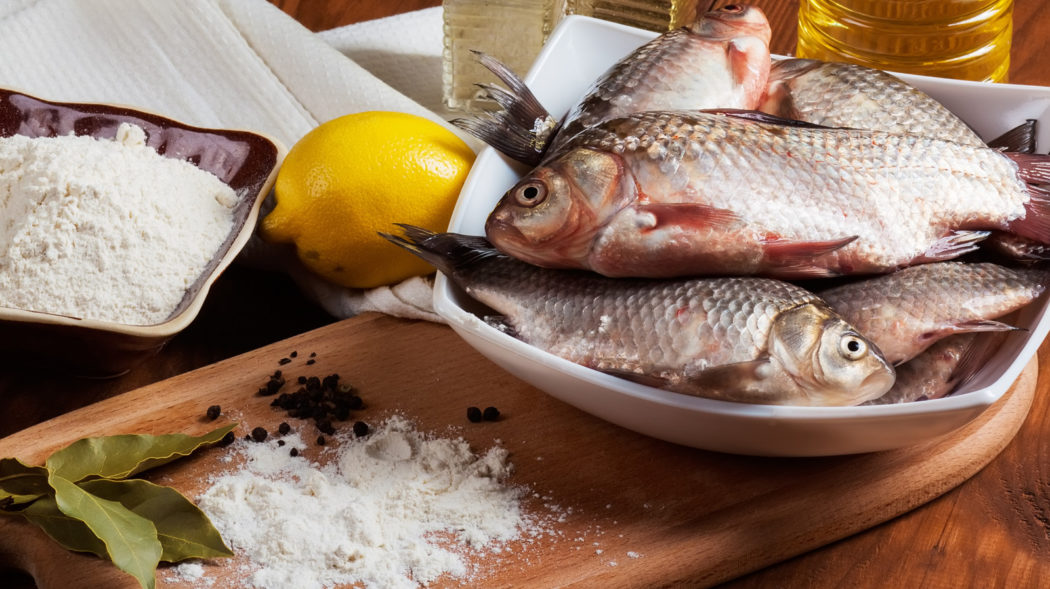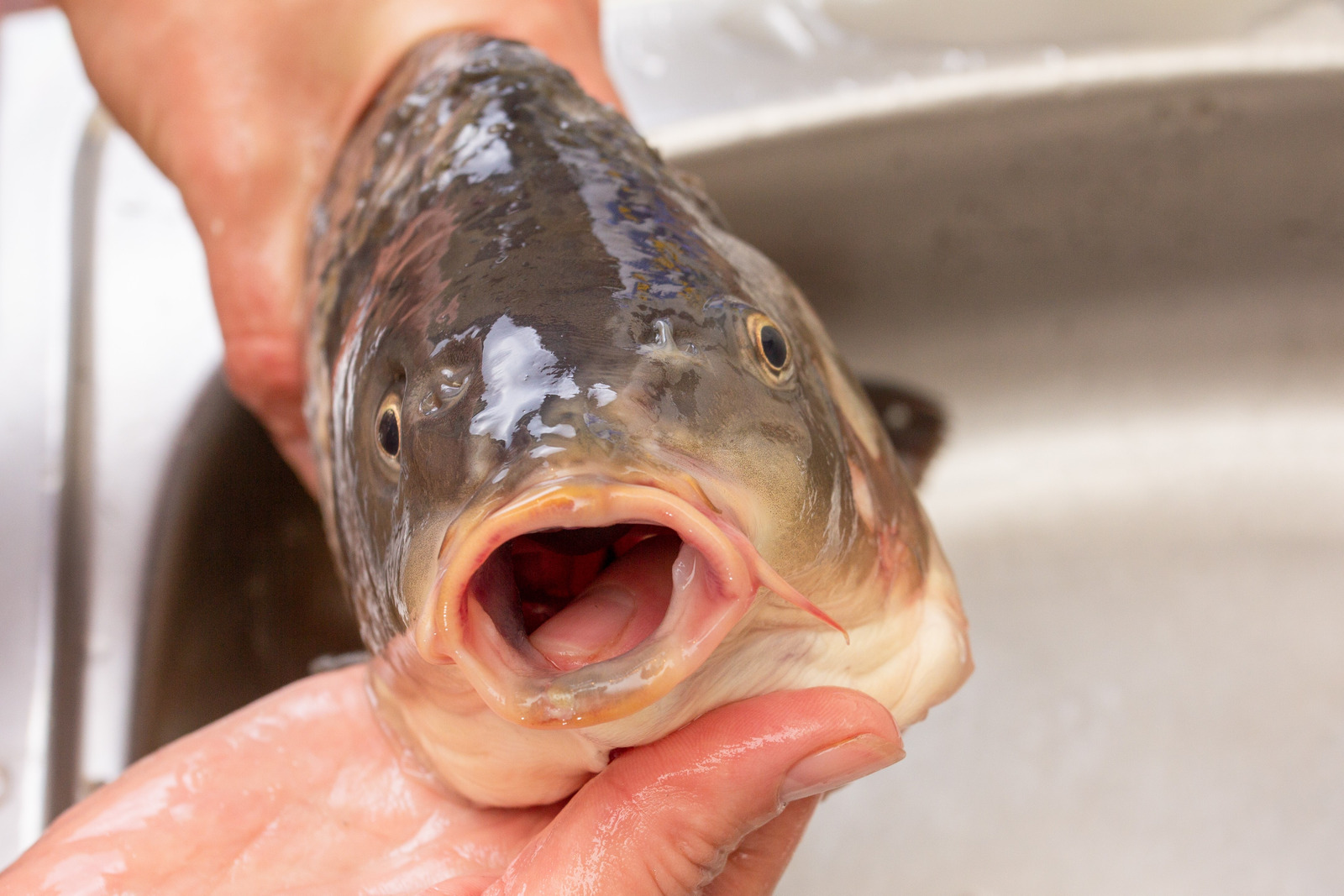Is Carp Good to Eat? Taste, Safety, Preparation

Carp is a hardy and popular fish found in many lakes, ponds and rivers around the world. It can grow quite large and is very common, prompting people to wonder, “is carp good to eat?”.
Yes, carp is good to eat! Carp is entirely safe to eat, is very healthy, and many people think it tastes excellent!
This article discusses all the important information you need to know about carp as a source of food: Is it good to eat? What a carp fish taste like, and how to prepare it safely for cooking?
What Is The Best Carp Species For Eating?
There are many types of carp, but the two most popular ones for eating are the common carp and the mirror carp. A common carp can grow up to four feet long and weigh over 40 pounds, while mirror carp is typically smaller, only growing up to three feet long.
Both types of carp have a mild flavor that some people find delicious. If you wonder which type of carp is best to eat, we recommend trying both and seeing which one you prefer.
Is Carp Good To Eat?
If you wonder whether carp is good to eat, the answer really depends on your personal preferences. As we mentioned before, some people think carp tastes excellent, while others find it a bit bland. Some people enjoy the taste of carp, while others find it to be an oily fish.
What Does A Carp Fish Taste?
Where the carp fish came from and how it was handled and prepared will have a significant effect on its taste and flavor. A not properly cleaned carp will have a muddy taste and fishy flavor, while a carp caught in clean waters and cleaned properly will have a unique and relatively mild flavor. Carp has moist and flaky meat, and because of its high oil content, it is favorably compared to salmon and tilapia.
What Are The Benefits Of Eating Carp?
In some parts of the world, carp is considered a delicacy and is eaten on special occasions. Carp is rich in Omega-three fatty acids and is an excellent source of protein, which is very beneficial in maintaining a healthy heart and overall health.
Besides being a food source, carp also has several other benefits. For example, anglers often use carp as baitfish because they are easy to catch (by just using fake bread as bait or even garlic) and they struggle when hooked. Some health benefits of eating carp are:
- The ability to improve heart health
- Help lower the inflammation
- Protect respiratory health
- Optimize digestive functions
- Slow the aging process
- Fend of chronic diseases
Is Carp Meat Clean?
The quality of the carp’s meat depends on the environment it lives in. If you catch a carp in polluted or muddy water, the carp taste will have a muddy smell and taste. However, a carp from clean, pollution-free water will give clean, pollution-free meat.
So, if you want to buy or catch a carp fish for food, make sure that it comes from the cleanest water possible, where the carp eat a healthy, diverse diet of insects, worms, mollusk, and aquatic plants. If the carp is from clean water, you will not taste the muddy flavor that others complained about carp meat.
Choosing The Best Carp Meat For Food
When choosing the best carp meat for food, make sure that the fish comes from a clean source and that it has been appropriately cleaned and gutted. You also want to make sure that the fish you select is fresh and does not have bruises or blemishes. So if you catch carp or buy live fish from fish markets, clean the fish immediately to preserve the meat quality and taste.
How Carp Compares To Other Fish Species
Carp is a relatively mild-flavored fish, which some people find delicious. Compared to other fish species, carp is a very adaptable fish and can be an ingredient in many recipes. Carp is lower in mercury and other toxins making it a safe choice for anyone who wants to live a healthy diet.
Carp is a good source of protein, omega-three fatty acids, and vitamins and minerals. These factors make carp a great choice if you are looking for healthy and delicious fish to add to your diet.
Cleaning And Preparing Carp For Cooking
Cleaning and preparing carp for cooking is a relatively simple process. Below are simple steps you can follow to clean and prepare carp for cooking.
Fresh Carp
If you bought or catch a live carp, let it live for a few days in a big tub of fresh water to clean the mud vein. Do not feed because this will help clean the fish. Put a dissolved salt (1 teaspoon) in the tub of water every day. Dissolving a teaspoon of salt will help improve the taste of the fish.
To clean the fish, first, stun it with a hammer while pinning it against the side of the tub with one hand. When it’s dead, the fish is then ready to be gutted and scaled.
Scaling Carp
Carp has large thick scales, which are over ½ inch wide. To scale, start by drawing the knife or scaler across the body from head to tail and then pressing to remove the scales. Rinse the carp fish with water and then pat it dry with a paper towel.
Gutting Carp
To gut the carp, you need to make a small incision in its belly to remove the organs inside. Once the guts are removed, rinse the fish again with cold water.
Filleting Carp
To minimize the cleaning process, you can fillet the fish before gutting it. Start by cutting behind the gills of the fish with a sharp knife. Put a little slice on the backbone and ribs, and then lift it while slicing towards the tail. When the first side is done, flip the fish over and start the same process on the other side and prepare carp for skinning.
Skinning Carp Fillet
Usually, fish can be grilled with the skin on, but carp has a “mud vein” under its skin, which should be removed for a better-tasting carp fish. To remove the mud vein, you need to skin the fish first.
Begin skinning by placing the fish fillet on the cutting board with the meat side up and gently cutting along the one end of the fillet until you can lay your knife sideways in the slit. Carve the knife with pressure towards the cutting board in long strokes while holding the skin back with your non-dominant hand.
Removing The Mud Vien
Remove the mud vein by making a v-cut on the side of the dark lateral line of the carp fish. Then gently remove the meat and vein that runs along with it.
Delicious Recipes That Use Carp As The Main Ingredient
Now that you know everything there is to know about carp, it’s time to try some delicious recipes that use this fish as the main ingredient. Cooking carp can be easy, as there are many ways. You can cook carp deep fried, baked, and grilled. Below are two of our favorites:
Carp Fried Rice: Fried rice with carp is a great way to use any leftover carp you may have. You can make this recipe by pan frying some rice in a pan with some oil, adding chopped vegetables and diced carp, and seasoning to taste.
Carp Curry: This curry is a traditional dish from Asia that is made with coconut milk, spices, and, of course, carp. It’s a hearty and filling dish that is a perfect meal for anyone on a cold winter day.
The History Of Carp As Food
Carp is a tasty fish and has been consumed in Asia and Europe for thousands of years. It is native to Asia and parts of Europe and was introduced around the world because of its popularity as a prized source of food.
It was considered a lucky fish in Asia and food that fit for the tables of kings and emperors. A carp fish delicacy would often grace the feasts of the rich and mighty. King Henry VIII of England has even set up his own carp pond to provide carp for his table.
In the United States, carp fish was introduced in the mid -19th century by European immigrants who brought along with them their favorite fish dish. Carp were introduced in the United States, and many began to cook carp as food and stocked large amounts of different carp species in ponds, lakes, reservoirs, and rivers.
Although many people still think of carp as game fish or a trash fish, it is now considered a delicacy in the United States. Carp is served on the menu of expensive hotels and restaurants and on the table of many Americans who like to eat carp. Today, large-scale carp fishing and farming operations demand has grown throughout the country and the world.
What Carp Is, And Where It Comes From?
Carp are large freshwater fish that originated from Asia and Europe. This fish species belongs to the minnow family, which contains many species of freshwater fish. Carp are hardy fish and can live in a variety of habitats. They are farmed in Asia, Central Europe, and the Middle East.
Carp Facts:
- Diet: Omnivore
- Prey: Aquatic plants, insects, worms, crustaceans, and zooplankton
- Most Distinctive Feature: Tiny whiskers on each corner of its mouth
- Group Behavior: School
- Lifespan: Up to 40 years in captivity
- Weight: A large carp can weigh up to 49lbs
- Skin Type: Scales
- Color: Brown, blue, black, white, green, orange, silver
- Size: Carp can grow into a very large size fish. The average size for carp is about 30 inches long and weighs 8- 15 pounds, but some carp fish can grow into a larger size.
- Habitat: Carp fish species are usually found in stagnant or slow-moving waters. They can also be found in major rivers, stagnant ponds, and great lakes. Carp can tolerate a wide range of environmental conditions and can take low oxygen levels, pollutants, and turbidity that other fish and are always associated with degraded habitats and stagnant waters.
What Does Carps Fish Look Like?
Carp has small eyes, thick lips, a forked tail, and a single dorsal fin with serrated spines. Many carp fish species have a big round body. Compared to catfish, carp have many whiskers on the corners of their mouth to help them sense their surrounding environment and help get their food. Carp also has more prominent and thicker scales that can vary in color.
Carp have duller colors like brown, silver, green, black, and white (called ghost carp), and occasionally, a brighter orange or red color will arise. The average carp fish grows to 24 inches in length, and the largest carp measures up to 49 pounds.
What Are The Different Carp Species?
Below are the popular carp fish species:
Common Carp: Also known as European carp, this type of carp can be identified by the scale pattern over its whole body. They are long and lean and have two barbules on each side of their mouth. This type of carp is covered entirely by beautiful, replicating scales patterns. Their color varies from bronze to brown and has a reddish or sometimes orange tail fin.
Mirror Carp: The mirror carp can be identified by the scattered patches of scales all over its body. A mirror carp also has a more rounded and fuller shape than the common carp.
Grass Carp: The grass carp has a long, almost torpedo-shaped body. They are herbivorous, have long slender bodies, and rounded heads, and do not have barbules on each side of their mouth.
Bighead Carp: Bighead carp is a deep-bodied fish with a large toothless mouth and a very large head.
Silver Carp: The silver carp is an Asian carp. They have an intense silver color, a disproportionately large head, eyes that sit very low on their head, and an enormous upturned mouth.
Goldfish: The goldfish is actually a member of the crucian cap genus but was bred for its beauty
Koi: The koi is a popular fish in ponds and water gardens because of its attractive and unique patterns of bright orange and black markings all over its white body.
In summary, Is Carp Good To Eat?
Carp is good to eat. However, carp is not for everybody. Some people don’t like to eat carp while others love the carp taste. Carp can be delicious if they are cleaned, prepared, and cooked properly.
No matter what others think, carp is a famous delicacy consumed by people who like stronger fish flavor worldwide. There are many recipes to prepare carp that suit anyone’s taste, and they contain healthy fats for the health-conscious.
As an Amazon Associate, Fishermen's Angle earns from qualifying purchases. We get commissions for purchases made through links in this post.



